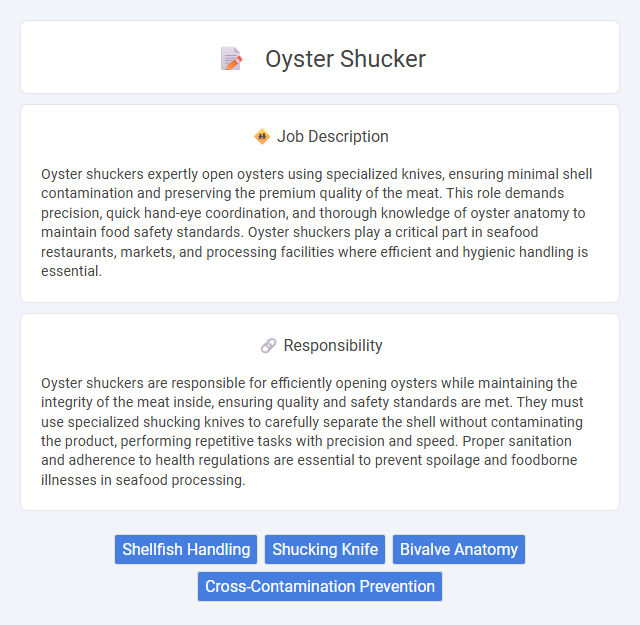
Oyster shuckers expertly open oysters using specialized knives, ensuring minimal shell contamination and preserving the premium quality of the meat. This role demands precision, quick hand-eye coordination, and thorough knowledge of oyster anatomy to maintain food safety standards. Oyster shuckers play a critical part in seafood restaurants, markets, and processing facilities where efficient and hygienic handling is essential.
Oyster shucking is likely suitable for individuals with good hand-eye coordination, manual dexterity, and the ability to work in cold, wet environments. Those prone to repetitive strain injuries or with limited hand strength may find the job challenging or unsuitable. The physical demands and potential exposure to shell fragments suggest it may not be ideal for people with certain allergies or mobility issues.
Qualification
Oyster shuckers require excellent hand-eye coordination and manual dexterity to efficiently open oysters without damaging the meat. Prior experience in seafood processing or culinary skills enhances performance, alongside knowledge of proper hygiene and safety protocols. Physical stamina and attention to detail are essential qualifications for maintaining speed and quality in a fast-paced environment.
Responsibility
Oyster shuckers are responsible for efficiently opening oysters while maintaining the integrity of the meat inside, ensuring quality and safety standards are met. They must use specialized shucking knives to carefully separate the shell without contaminating the product, performing repetitive tasks with precision and speed. Proper sanitation and adherence to health regulations are essential to prevent spoilage and foodborne illnesses in seafood processing.
Benefit
Oyster shuckers likely enjoy competitive pay due to the specialized skill required to efficiently open oysters without damaging the meat. There is a strong probability of job availability in coastal regions and seafood markets, providing steady employment opportunities. Workers might also benefit from a dynamic work environment that fosters dexterity and speed, enhancing both experience and earning potential.
Challenge
Oyster shucker jobs likely present significant challenges due to the precision and speed required to avoid damaging the delicate shellfish. The risk of injury from sharp shells and knives may be a common concern, necessitating careful technique and protective measures. Workers probably face physical strain from repetitive motions and demanding work environments near the coast or seafood markets.
Career Advancement
Oyster shucking offers valuable skills in hand-eye coordination and knife handling, forming a strong foundation for roles in seafood processing and quality control. Workers can advance to supervisory positions or specialize in seafood safety inspections, increasing their earning potential. Experience in oyster shucking also opens pathways to careers in culinary arts, particularly in seafood preparation and restaurant management.
Key Terms
Shellfish Handling
Oyster shuckers specialize in shellfish handling by efficiently opening oysters while maintaining the integrity and freshness of the shellfish. Skilled at using specialized knives, they carefully remove the oyster meat from the shell, ensuring minimal contamination and preserving quality for consumption. Proper shellfish handling techniques are critical to prevent spoilage and ensure food safety in seafood processing environments.
Shucking Knife
A shucking knife is an essential tool for oyster shuckers, designed with a short, sturdy blade that allows precise extraction of oysters from their shells. The blade's tip is typically pointed or rounded to carefully pry open the shell without damaging the delicate meat inside. Proper use of a shucking knife enhances efficiency and safety, reducing the risk of injury during oyster preparation.
Bivalve Anatomy
An oyster shucker expertly handles bivalve mollusks, carefully navigating the hinge and adductor muscles to open the shell without damaging the delicate meat inside. Mastery of bivalve anatomy, including the identification of the mantle, gills, and labial palps, ensures efficient extraction of oysters for consumption or sale. Precision in shucking preserves the oyster's quality and minimizes contamination risks associated with the visceral mass and gut areas.
Cross-Contamination Prevention
Oyster shuckers maintain strict hygiene protocols to prevent cross-contamination between raw shellfish and work surfaces. They regularly sanitize knives, gloves, and cutting boards to eliminate bacteria transfer risks. Proper handling and storage of oysters are essential to ensure food safety and compliance with health regulations.
 kuljobs.com
kuljobs.com